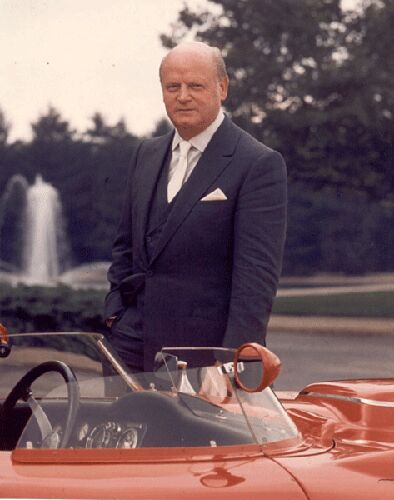564 Views
Was GM Design Head Bill Mitchell A Sexist Bigot?

by
Ronnie Schreiber
(IC: employee)
Published: November 29th, 2010
Share
Bill Mitchell, only the second man to head General Motors styling when he took over from the monumental Harley Earl, was not a man about whom people were impartial. GM’s official history reveres him. Harley Earl’s family reviles him. His coworkers and subordinates at GM either loved him or despised the man. Even landmark designs that were signatures of his reign at GM Styling, the split-window 1963 Corvette Sting Ray and the boat tail Rivieras, are polarizing designs that had detractors, including some on the GM Styling staff. He admittedly ran that department like a dictator, though he rarely fired anyone. Mercurial in temper, he’d have screaming fits at his design staff, laced with the most vulgar epithets, then defuse the tension with an offhand joke as he left the room. Shamelessly ambitious and self-promoting, often taking personal credit for his staffs’ designs, had the term “larger than life” not existed, Mitchell would have coined it to describe himself.By today’s standards of workplace political correctness, diversity and racial and sexual harassment law, Bill Mitchell was an atavistic throwback to an age when ethnic jokes by supervisors were uncomfortably endured by the brunt of that ‘humor’. An executive then could tell his secretary to order him up some hookers after a multiple martini lunch, knowing that she’d hold all calls and cover for him if his wife (or another executive) got jealous. As a result, in addition to whatever praise and criticism his aesthetic direction and management skills have garnered, Bill Mitchell’s legacy has been somewhat tarred with the brush of bigotry.The question is are we being fair to the man? Are we applying contemporary standards to an era that was simultaneously more innocent and more evil in terms of racial, ethnic and other prejudice?

Ronnie Schreiber
Ronnie Schreiber edits Cars In Depth, the original 3D car site.
More by Ronnie Schreiber
Published November 29th, 2010 12:27 PM
Latest Car Reviews
Read moreLatest Product Reviews
Read moreRecent Comments
- 1995 SC Man it isn't even the weekend yet
- ToolGuy Is the idle high? How many codes are behind the check engine light? How many millions to address the traction issue? What's the little triangular warning lamp about?
- Ajla Using an EV for going to landfill or parking at the bad shopping mall or taking a trip to Sex Cauldron. Then the legacy engines get saved for the driving I want to do. 🤔
- SaulTigh Unless we start building nuclear plants and beefing up the grid, this drive to electrification (and not just cars) will be the destruction of modern society. I hope you love rolling blackouts like the US was some third world failed state. You don't support 8 billion people on this planet without abundant and relatively cheap energy.So no, I don't want an electric car, even if it's cheap.
- 3-On-The-Tree Lou_BCone of many cars I sold when I got commissioned into the army. 1964 Dodge D100 with slant six and 3 on the tree, 1973 Plymouth Duster with slant six, 1974 dodge dart custom with a 318. 1990 Bronco 5.0 which was our snowboard rig for Wa state and Whistler/Blackcomb BC. Now :my trail rigs are a 1985 Toyota FJ60 Land cruiser and 86 Suzuki Samurai.


































Comments
Join the conversation
Another question to add to the list: Was Bill Mitchell a thief? General Motors, developed during Mitchell's time as design chief, used images conceived and drawn by yours truely as the designs on an estimated ten million Cadillac's, Oldsmobile's, Buick's and Chevrolet's produced and sold during the 1977-1990 model years. Thing is those designs were taken without permission from an art portifolio I submitted to Dr. David H. Harry at General Motors Institute and copies of my originals made in person by Dr. George Bush of Northwood University between 1972 and 1975.
Same as it ever was. If people spent more time creating and quit bickering about how I have been oppressed the USA might become a strong country again today. This I am African American, Mexican American, insert __________American BS needs to stop. How many blacks have even been to Africa? Mitchell was what he was but still created some beautiful designs. As to the last reply about being a thief, I don't know if I would be so proud of the 70s-90s designs as that is when GM built the worst cars ever, of course my opinion. I think others thought so as GM went bankrupt.